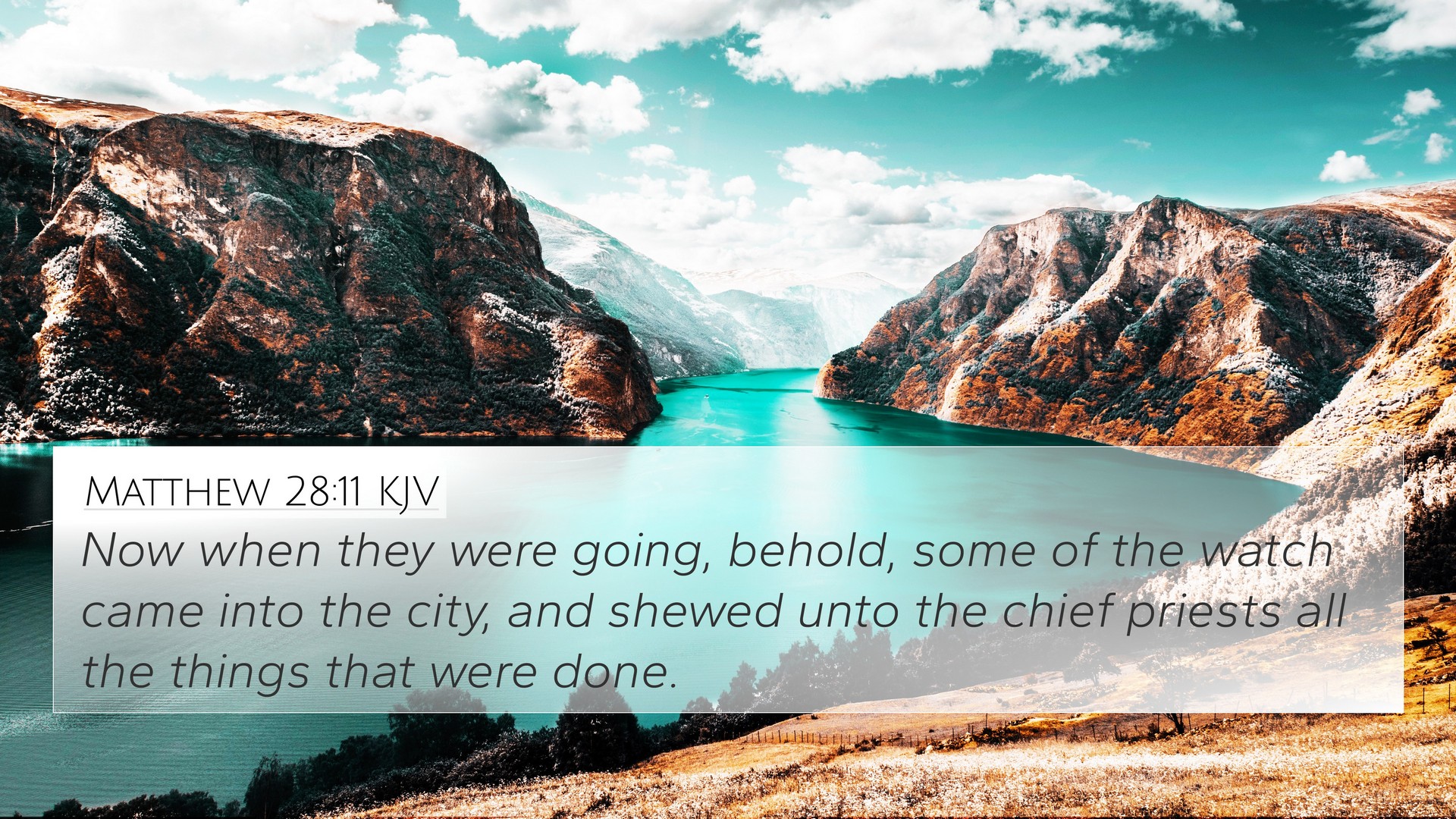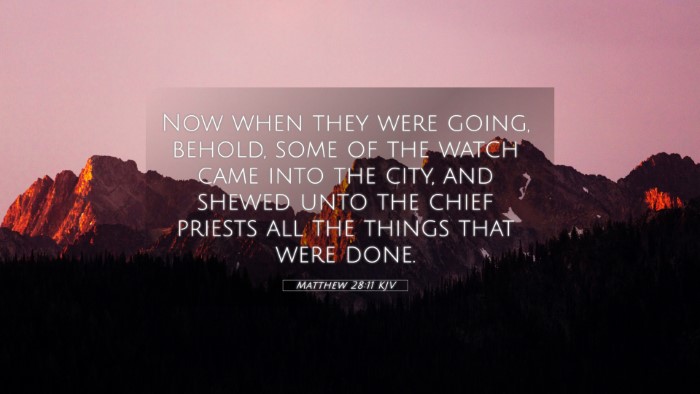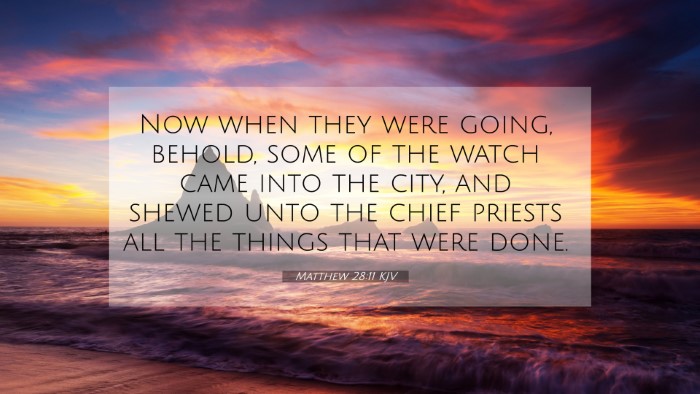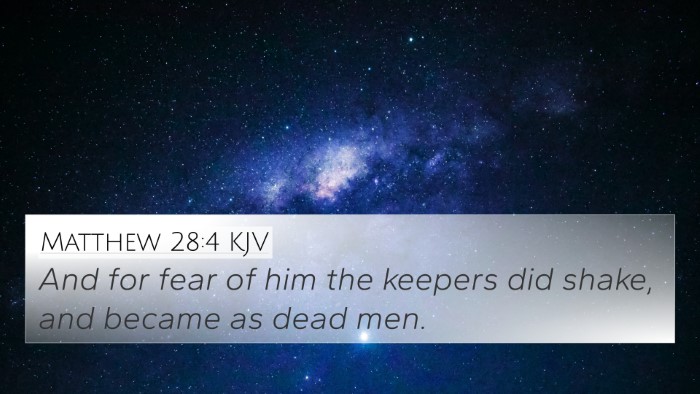Understanding Matthew 28:11
Verse: Matthew 28:11 - "While they were going, some of the guard went into the city and told the chief priests all that had taken place."
Overview
This passage takes place after the resurrection of Jesus Christ. The guards, who were assigned to keep watch over the tomb, experienced a miraculous event when the stone was rolled away and found the tomb empty. This verse presents a crucial moment where those tasked to guard the dead found themselves as witnesses to the significant event of the resurrection.
Commentary Insights
- Matthew Henry: Henry emphasizes the fear experienced by the guards after witnessing the angel's descent and the resurrection of Jesus. Their decision to report the resurrection to the chief priests highlights the profound impact of these events upon those who were given authority.
- Albert Barnes: Barnes points out the contrast between the guards' awareness of the resurrection and the disbelief of the religious leaders. His commentary reflects on the irony that the very individuals who were expected to uphold the truth were now the ones to suppress it.
- Adam Clarke: Clarke elaborates on the motivations of the guards and the possible consequences they faced. He underscores the historical context of their actions and the implications of their testimony for the Jewish leadership.
Key Themes and Cross-References
This verse can be analyzed through various lenses, offering multiple connections to other scriptures.
- 1. Resurrection of Jesus: John 20:1-18 - The detailed account of Mary's discovery of the empty tomb resonates with the guards' experience.
- 2. The Role of Witnesses: Acts 1:8 - The calling of the disciples to be witnesses connects with the guards' unwilling shift from protectors to proclaimers.
- 3. Fear and Awe: Luke 24:4 - The fear displayed by the women and the guards in the face of angelic messages marks a thematic pattern throughout the resurrection account.
- 4. Faith and Unbelief: John 12:43 - This passage speaks to the fear of the Jewish leaders who preferred human approval over divine truth, which parallels the reactions of the guards.
- 5. Conspiracy to Suppress the Truth: Matthew 28:12-15 - This immediate follow-up to 28:11 illustrates the lengths to which the leaders would go to conceal the resurrection.
- 6. The Commissioning of the Disciples: Matthew 28:16-20 - This segment connects the guards' testimony to the Great Commission given to the disciples, linking the urgency of the message.
- 7. Prophecy Fulfilled: Isaiah 53:5 - Reflect on the suffering servant's role as prophesied and recognized in the resurrection event, highlighting God’s sovereignty.
Comparative Bible Verse Analysis
A comparative analysis of Matthew 28:11 with related verses reveals a pattern of responsiveness to divine revelation. Each act of witnessing serves as a precursor to belief and solidifies the foundational truths of the Gospel.
Connecting Themes and Insights
The themes emerging from Matthew 28:11 resonate deeply within the broader narrative of the Gospels. The guards' transition from authority figures to messengers of a divine occurrence serves as a vital reminder of how God can use unlikely witnesses to spread truth.
Further Reflections on Cross-Referencing
When studying the Bible, utilizing tools for cross-referencing can enhance understanding. Resources such as a Bible concordance or a Bible cross-reference guide play crucial roles in discovering connections between verses.
For example, seeking to identify connections between the Old and New Testaments, or performing a comparative study between the Gospels can unveil layers of meaning and thematic relevance. Employing a bible reference resource can aid in a deeper exploration of related scriptures.
Conclusion
In Matthew 28:11, we find a pivotal moment of witness that underscores the reality of Jesus’ resurrection. By exploring inter-Biblical dialogue, believers can come to appreciate how various scriptures interact, providing a richer understanding of the resurrection and the urgency of spreading its message. In this way, we engage in a profound journey of faith, echoing the calls of the witnesses of Christ's resurrection.




